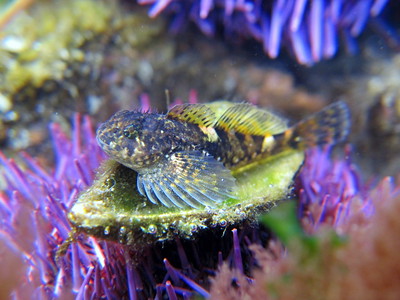Both appearance and behavior benefit this fish.
 Usually, it’s the behavior that catches people’s eyes. The mottled patterns that cover the entire body of sculpins help it blend extremely well with the tidepool bottom.These common fish are shaped like long, drawn-out teardrops, but with broad pectoral fins located just past the head. Rather triangular in cross section and with a long fin that runs down the back, tidepool sculpins rest on the bottom with their pectoral fins spread out on either side. The entire body is variously marked in browns, olive greens, and whites—often in saddles across the back. All of the several different species of tidepool sculpins are small, up to several inches long.
Usually, it’s the behavior that catches people’s eyes. The mottled patterns that cover the entire body of sculpins help it blend extremely well with the tidepool bottom.These common fish are shaped like long, drawn-out teardrops, but with broad pectoral fins located just past the head. Rather triangular in cross section and with a long fin that runs down the back, tidepool sculpins rest on the bottom with their pectoral fins spread out on either side. The entire body is variously marked in browns, olive greens, and whites—often in saddles across the back. All of the several different species of tidepool sculpins are small, up to several inches long.
The fish will rest/hide quietly, but, when disturbed, will dash off to a new location where it freezes suddenly to blend into the new background, seeming to disappear.
Can you find tidepool sculpins of more than one pattern?
The Oregon Coast is home to several species of sculpins that spend their entire lives in the tidepool zones; some larger sculpin species may live in tidepools when young.
These common fish are shaped like long, drawn-out teardrops, but with broad pectoral fins located just past the head. Rather triangular in cross section and with a long fin that runs down the back, tidepool sculpins rest on the bottom with their pectoral fins spread out on either side. The entire body is variously marked in browns, olive greens, and whites—often in saddles across the back. All of the several different species of tidepool sculpins are small, up to several inches long.
Rarely, tidepool sculpins may misjudge and get caught and eaten by larger sea anemones. More often, they fall prey to larger fish (at high tide) and shorebirds (at low tide).
